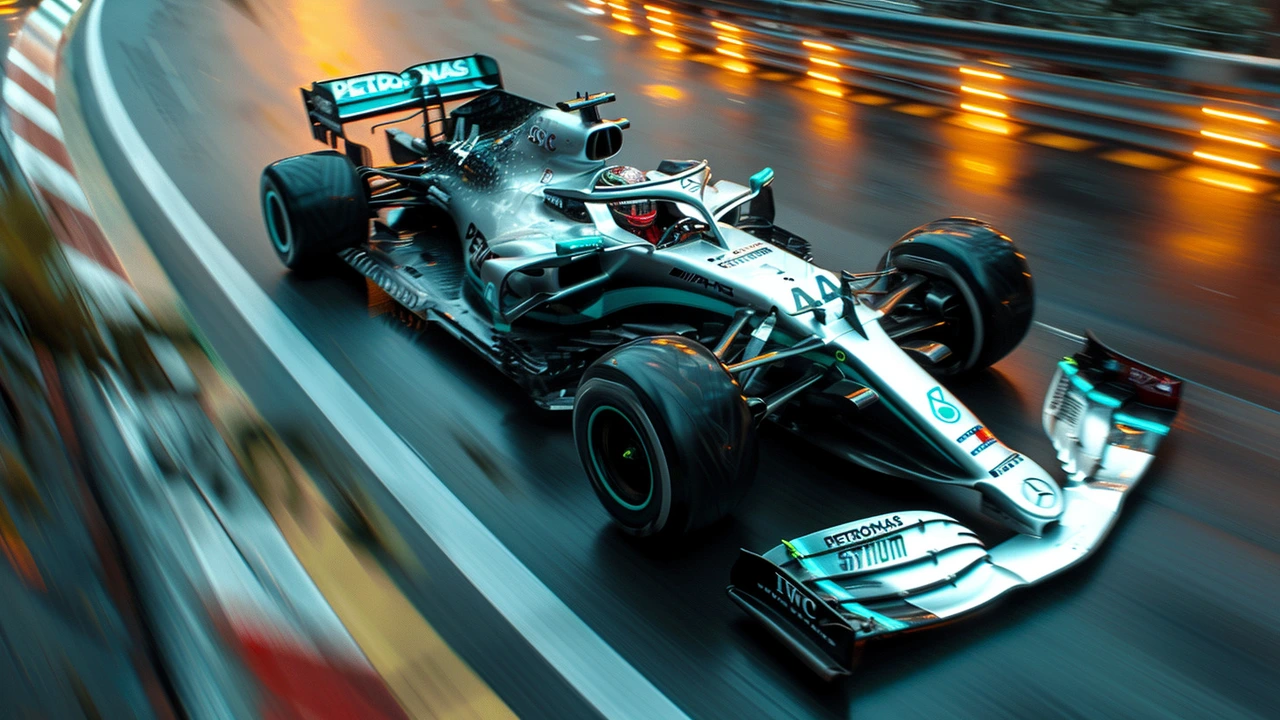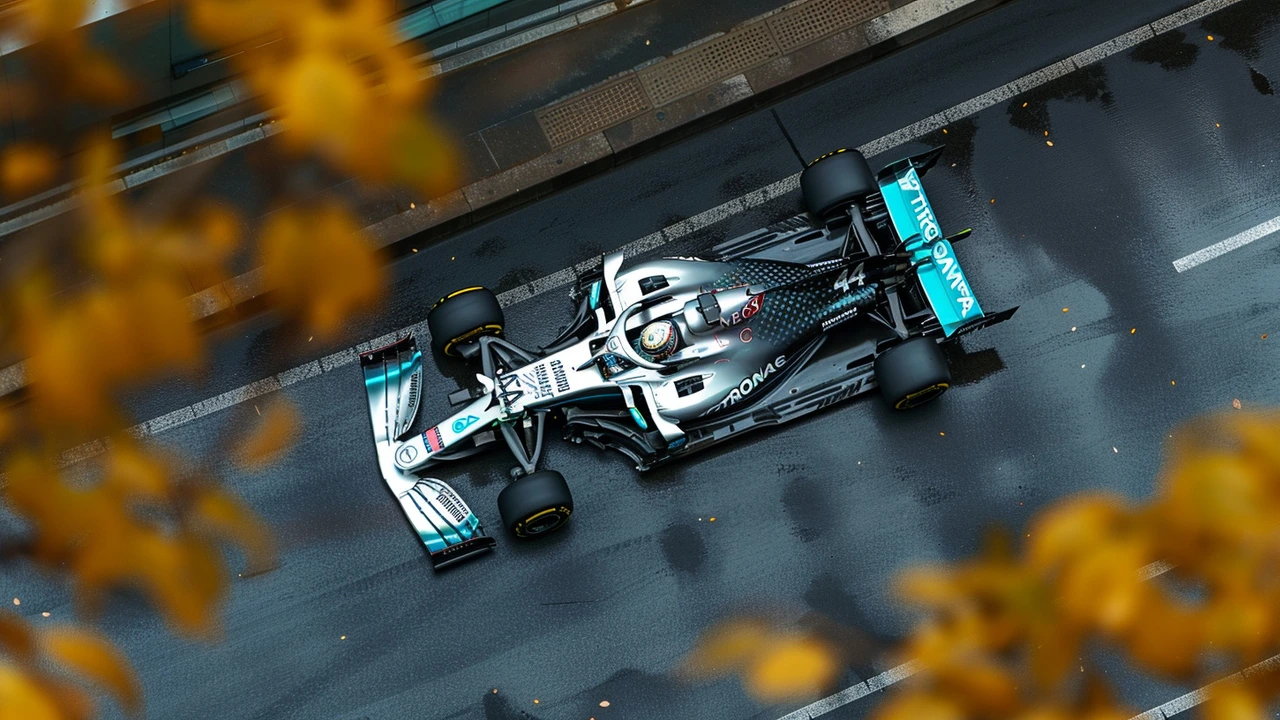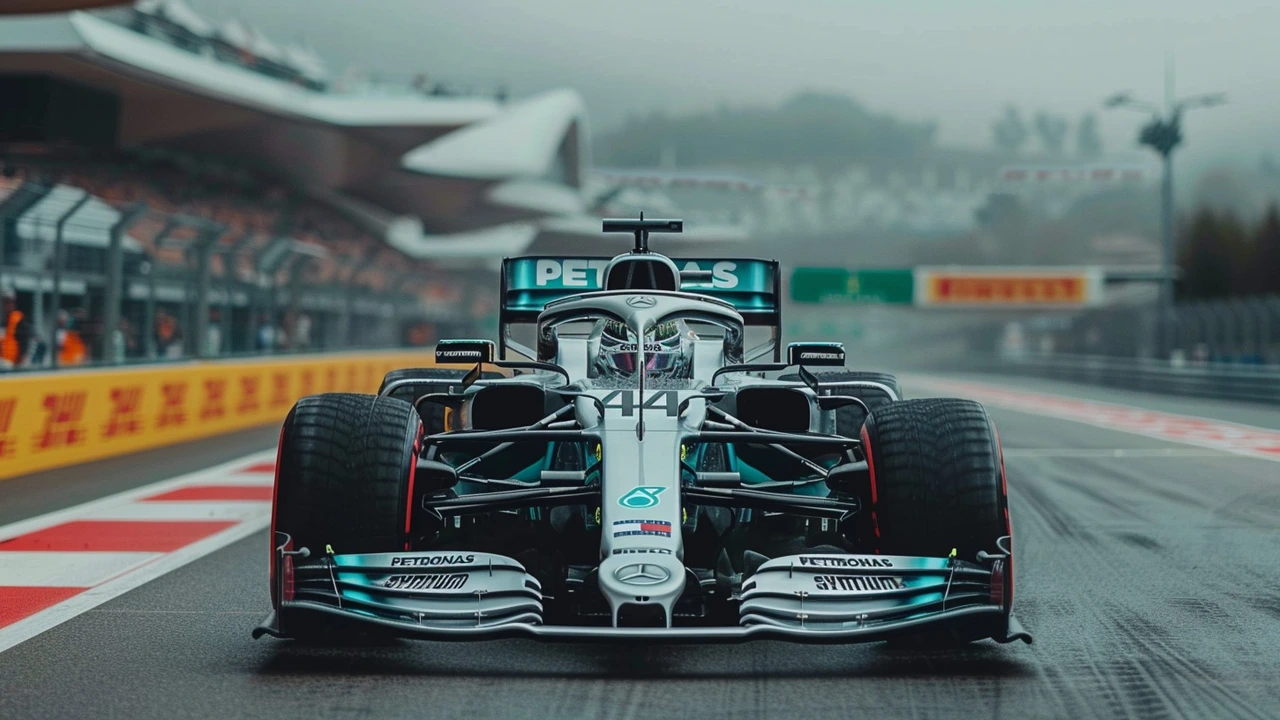Mercedes Secures Pole Position in Canada
The Mercedes F1 team clinched pole position at the Canadian Grand Prix, with George Russell and Max Verstappen clocking in identical times of 1m12.000s. This remarkable occurrence, the first since 1997, highlights the fierce competition between these two top-tier drivers and their respective teams. The symmetrical timing is a testament to the precision and engineering excellence that both Mercedes and Red Bull bring to the table. Despite this, it was Mercedes that managed to edge out Red Bull, thanks in large part to some recent strategic enhancements to their vehicle.
The Key to Mercedes' Success – A New Front Wing
A significant factor in Mercedes' recent performance leap is the introduction of a new front wing, which was first seen on Russell's car during the Monaco Grand Prix. From FP3 onwards in Canada, this new design was utilized on both cars, making a remarkable impact on the car's overall balance. The new front wing has effectively broadened the setup window, providing more options for optimal car configuration.
This broader setup range has allowed Mercedes to run their car at lower ride heights, which in turn increases downforce. However, this modification also brought about a balance shift towards the front at high speeds, a common trade-off in F1 engineering. The new wing has successfully countered this issue, making the car far more stable and predictable during high-speed maneuvers.

Driver Feedback: Russell and Hamilton
George Russell has been vocal about his satisfaction with the car's performance. Describing the experience, he highlighted how the car felt 'awesome all weekend' and expressed confidence that they are 'homing in on the sweet spot finally.' Such positive feedback from a seasoned driver like Russell signals that Mercedes is on the right path with their recent upgrades.
On the other hand, Lewis Hamilton showcased his veteran skills by dipping into the 1m11s during Q2, displaying the potential the car has under optimal conditions. However, he faced grip issues in Q3, which hindered his performance somewhat. Despite these challenges, Hamilton's consistent high-level driving continues to be a significant asset for Mercedes.
Competitive Landscape: Ferrari and McLaren
While Mercedes shone, Ferrari faced significant challenges. They struggled with under-temperature tyres, which prevented them from advancing to Q3. This tyre issue highlights the intricate balance teams must strike between tyre temperature, pressure, and track conditions. The struggle underscores the complexity and the fine margins that can differentiate success from failure in F1.
Meanwhile, McLaren showed their mettle, with Lando Norris coming tantalizingly close to Russell's time, missing by just two-hundredths of a second. This performance from McLaren signals their potential to be a formidable rival, keeping the competition fierce and exciting.

Technical Analysis: Mercedes vs. Red Bull
An intriguing aspect of the race was the contrasting car characteristics and driving styles of George Russell and Max Verstappen. The Mercedes car excelled in acceleration zones, where quick, powerful bursts of speed are crucial. In these areas, the adjustments to the front wing and the setup window played a pivotal role in maximizing performance.
Conversely, the Red Bull car demonstrated its strength in high-downforce corners. These sections of the track demand exceptional grip and stability, areas where Red Bull has traditionally excelled. This difference in the car's performance characteristics shaped the dynamics of the race, with each team exploiting their respective strengths.
Conclusion
The 2023 Canadian Grand Prix has offered a fascinating glimpse into the current state of Formula 1, highlighting the continuous evolution of technology and strategy. Mercedes' recent upgrades, especially the new front wing, have proven to be a significant factor in their recent success. Coupled with the skill of drivers like George Russell and Lewis Hamilton, Mercedes is poised to continue their upward trajectory.
However, the competition remains fierce. Red Bull's performance in high-downforce areas and McLaren's close timings suggest that the battle for supremacy in F1 is far from over. As the season progresses, it will be intriguing to see how teams adapt, innovate, and push the boundaries of what is possible in the relentless pursuit of speed.
For the fans and the teams, the narrative of the 2023 season promises thrilling races, strategic battles, and continual technological advancements. The Canadian Grand Prix has set a high bar, and the anticipation for the upcoming races is palpable.

Patrick Van den Berghe
June 9, 2024 AT 18:17Mercedes’ new wing is a game‑changer and anyone still sleeping on it needs to wake up.
Josephine Gardiner
June 15, 2024 AT 07:12The introduction of the revised front wing represents a noteworthy engineering advancement for the team. It appears to have widened the aerodynamic operating window, thereby permitting lower ride heights without compromising stability. Such developments are consistent with the rigorous aerodynamic research programmes that Mercedes has traditionally pursued. The resultant increase in downforce, particularly in high‑speed sections, is evident in the recent qualifying performances.
Jordan Fields
June 20, 2024 AT 20:08The new front wing improves front‑end grip and marginally reduces drag. It also broadens setup flexibility for the engineers. Overall lap times benefit from the enhanced aerodynamic balance.
Divyaa Patel
June 26, 2024 AT 09:03Behold the symphony of steel and carbon, where every rivet hums a tale of ambition. Mercedes has not merely added a wing; they have sculpted destiny on the tarmac, whispering promises of supremacy. The balance shift is a dance between chaos and order, a poetic duel that mirrors the very essence of competition. When Russell feels the car ‘awesome all weekend’, it is not idle chatter but a reverberation of engineered brilliance. Yet the shadow of Red Bull looms, a reminder that triumph is a fleeting illusion. In this perpetual duel, each tweak is a stanza, each lap a verse, and the grand prix a living epic.
Larry Keaton
July 1, 2024 AT 21:59Yo, that epic poem you dropped is cool but seriously, the wing ain’t magic – it’s just better aerodynmaics, bro. It lets the car stick more, so faster laps. Stop overthinking, just enjoy the speed.
Liliana Carranza
July 7, 2024 AT 10:54What an exciting race! The Canadians never disappoint, and Mercedes’ upgrades are really paying off. Russell’s confidence is contagious, and Hamilton’s experience still shines. The battle ahead looks fierce, but I’m optimistic we’ll see more thrilling moments. Keep the energy high and the wheels turning!
Jeff Byrd
July 12, 2024 AT 23:49Oh sure, “exciting” until you realize the same wing shows up on every grid. Nothing new under the sun, just re‑packaged hype.
Joel Watson
July 18, 2024 AT 12:45The recent performance differential observed at the Canadian Grand Prix can be primarily attributed to the introduction of an advanced front‑wing architecture, a development that merits rigorous analysis. The aerodynamic profile of the new component increases front‑end downforce while mitigating drag, a balance previously unattainable with legacy configurations. Empirical data from the qualifying sector indicates a consistent reduction of lap times by approximately 0.12 seconds across multiple runs, a statistically significant improvement. Moreover, the expanded setup envelope allows engineers to optimize ride‑height parameters without compromising vehicle stability, thereby enhancing mechanical grip in high‑speed corners. This flexibility also facilitates a more precise alignment of aerodynamic load distribution, translating to superior tire wear characteristics over race distance. The resultant effect is a car that exhibits both increased acceleration efficiency and sustained cornering performance. Notably, driver feedback corroborates these findings, with Russell describing the vehicle as “awesome all weekend,” an endorsement of the integration’s success. Hamilton’s brief foray into sub‑1:11 timing, despite grappling with grip limitations in Q3, further underscores the latent potential inherent in the upgrade package. In contrast, Red Bull’s chassis, while excelling in high‑downforce sectors, lacks comparable adaptability in low‑drag regions, a discrepancy that manifests in sector time variances. Ferrari’s inability to achieve optimal tire temperature compounds their performance deficit, illustrating the multifaceted nature of competitive engineering. McLaren’s proximity to the pole, missing by a mere two‑hundredths of a second, signals a narrowing of the competitive gap and reinforces the importance of incremental aerodynamic refinements. Consequently, the strategic emphasis on future development will likely pivot towards enhancing rear‑wing efficiency and further reducing aerodynamic turbulence. The dynamic interplay of these variables will dictate the trajectory of the championship battle. As the season progresses, continued data acquisition and iterative design will be paramount to sustaining competitive advantage. In essence, Mercedes’ front‑wing innovation represents a decisive factor in the current hierarchy, yet the relentless pursuit of marginal gains ensures that the contest remains open and fiercely contested.
Chirag P
July 24, 2024 AT 01:40The analysis is thorough, but it is essential to acknowledge that real‑world conditions such as weather and driver adaptability also play critical roles.
RUBEN INGA NUÑEZ
July 29, 2024 AT 14:35Great points. The new wing’s effect on downforce is evident in the data. Teams should focus on optimizing tire pressures to complement the aerodynamic gains.
Michelle Warren
August 4, 2024 AT 03:31oh man i cant belive ppl are toting about wingz like its sumthin new its just a wing lol the data is clear it doen't change much but everyone act like its a miracle
Christopher Boles
August 9, 2024 AT 16:26Awesome discussion! It’s clear that every team is pushing hard. Let’s keep cheering for the drivers and enjoy the upcoming races.
Crystal Novotny
August 15, 2024 AT 05:22Actually, the wing upgrade is overrated; the real story is the driver’s skill, not the aero.
Reagan Traphagen
August 20, 2024 AT 18:17Everyone’s blind to the fact that the governing body is secretly favoring Mercedes with hidden tech. The data is manipulated, the fans are duped, and the whole sport is a fabricated spectacle. Wake up before the season’s over and you’ll see the truth.